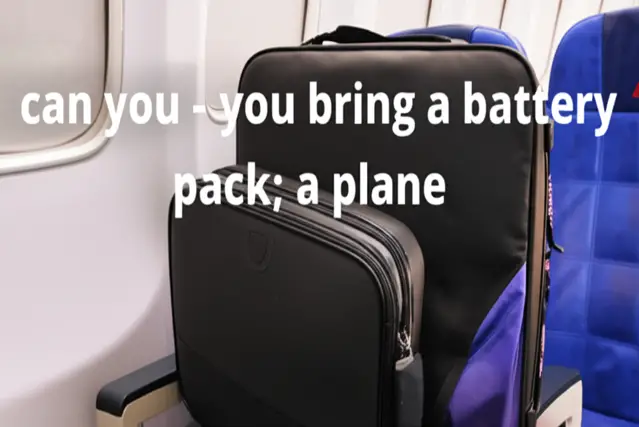Traveling with electronics is now a standard part of modern life, and with those devices comes the inevitable need for portable phone chargers on a plane. But can you bring a battery pack on a plane? The answer isn’t always straightforward.
Regulations surrounding battery packs can be confusing, varying based on the type of battery, its size, and the airline you’re flying with. This comprehensive guide will break down everything you need to know to ensure your travels are smooth and compliant with all safety regulations.
Table of Contents
Why Are There Restrictions on Battery Packs?
Before diving into the specifics, it’s crucial to understand why airlines and aviation authorities have implemented these restrictions. The primary concern is safety. Lithium-ion batteries, commonly found in battery packs, can pose a fire risk due to:
- Overheating: Batteries can overheat if they are damaged, short-circuited, or improperly manufactured.
- Thermal Runaway: In extreme cases, overheating can lead to a thermal runaway, a chain reaction that causes the battery to rapidly increase in temperature, potentially leading to fire or explosion.
- Cargo Fires: Fires in the cargo hold can be particularly dangerous because they are difficult to detect and extinguish quickly.
To mitigate these risks, aviation authorities like the Transportation Security Administration (TSA) in the United States and the International Air Transport Association (IATA) have established regulations for transporting batteries on aircraft.
General Guidelines for Battery Packs on Planes
The rules for carrying battery packs depend on several factors, but here’s a general overview:
- Type of Battery: Lithium-ion and lithium metal batteries are the most common types of batteries found in portable chargers. Regulations differ slightly between the two.
- Watt-hour (Wh) Rating: For lithium-ion batteries, the Wh rating determines whether the battery is allowed, and if so, under what conditions.
- Lithium Content: For lithium metal batteries, the lithium content (in grams) is the key factor.
- Carry-on vs. Checked Baggage: Generally, spare lithium batteries are only allowed in carry-on baggage.
Lithium-Ion Batteries: The Watt-Hour (Wh) Rating
Lithium-ion batteries are commonly used in smartphones, laptops, tablets, and, of course, battery packs. The key metric for these batteries is the watt-hour (Wh) rating, which indicates the amount of energy the battery can store. The TSA and IATA have specific guidelines based on this rating:

- Up to 100 Wh: These batteries are generally allowed in carry-on baggage without quantity limits (for personal use). Examples include batteries for smartphones, standard laptops, and many power banks.
- 101-160 Wh: These batteries require airline approval and are limited to a maximum of two per passenger. This category includes extended-life laptop batteries and larger power banks.
- Over 160 Wh: These batteries are generally prohibited from both carry-on and checked baggage due to safety concerns.
How to Find the Watt-Hour (Wh) Rating
The Wh rating is usually printed on the battery itself or on the device containing the battery. It can also be found in the product specifications or the user manual. If the Wh rating isn’t directly available, you can calculate it using the battery’s voltage (V) and amp-hour (Ah) rating:
Wh = V x Ah
If the battery is rated in milliamp-hours (mAh), convert it to amp-hours by dividing by 1000:
Ah = mAh / 1000
For example, a battery rated at 3.7V and 5000mAh would have a Wh rating of:
Ah = 5000 mAh / 1000 = 5 Ah
Wh = 3.7 V x 5 Ah = 18.5 Wh
This battery would fall well within the allowed range for carry-on baggage.
Table: Lithium-Ion Battery Regulations
| Watt-Hour (Wh) Rating | Allowed in Carry-on | Allowed in Checked Baggage | Airline Approval Required | Quantity Limits |
|---|---|---|---|---|
| Up to 100 Wh | Yes | No | No | No Limit (for personal use) |
| 101-160 Wh | Yes | No | Yes | Maximum of 2 per passenger |
| Over 160 Wh | No | No | No | Prohibited |
Lithium Metal Batteries: The Lithium Content
Lithium metal batteries are typically non-rechargeable and are often found in devices like watches, calculators, and some cameras. The regulations for these batteries are based on their lithium content, measured in grams:
- Up to 2 grams of lithium: These batteries are generally allowed in carry-on baggage. They can also be installed in a device in checked baggage.
- Over 2 grams of lithium: These batteries are typically prohibited from both carry-on and checked baggage unless specifically approved by the airline.
Table: Lithium Metal Battery Regulations
| Lithium Content | Allowed in Carry-on | Allowed in Checked Baggage | Airline Approval Required |
|---|---|---|---|
| Up to 2 grams | Yes | Yes (if installed in device) | No |
| Over 2 grams | No | No | Yes (usually prohibited) |
Best Practices for Traveling with Battery Packs
To ensure a hassle-free experience at the airport, follow these best practices when traveling with battery packs:
- Identify Battery Type and Rating: Before packing, determine whether your battery is lithium-ion or lithium metal and find its Wh rating or lithium content. This information is usually printed on the battery or device.
- Pack in Carry-on Baggage: Always pack spare lithium batteries in your carry-on baggage. This allows you to respond quickly if an issue arises and prevents potential hazards in the cargo hold.
- Protect Batteries from Short Circuits: To prevent short circuits, cover battery terminals with tape, place each battery in a separate protective pouch or plastic bag, or keep them in their original packaging.
- Obtain Airline Approval: If you have batteries with a Wh rating between 101 and 160 Wh, contact your airline in advance to obtain approval. Be prepared to provide details about the battery’s specifications.
- Declare Batteries if Necessary: Some airlines may require you to declare the number and type of batteries you are carrying during check-in.
- Check Airline-Specific Rules: While the TSA and IATA provide general guidelines, individual airlines may have additional restrictions or policies. Always check with your airline before traveling.
- Keep Documentation Handy: Carry the product specifications or user manual for your devices, especially if the Wh rating isn’t clearly marked on the battery. This can help resolve any questions from security personnel.
Specific Devices and Battery Pack Considerations
Certain devices and battery packs have unique considerations. Here are some common examples:
- Power Banks/Portable Chargers: These are typically lithium-ion batteries and should be treated accordingly. Check the Wh rating and pack them in your carry-on.
- Laptops and Tablets: The batteries in these devices are usually within the allowed range (under 100 Wh). You can carry them in your carry-on or checked baggage, but it’s generally safer to keep them with you.
- Cameras: Camera batteries are usually lithium-ion and should be packed in your carry-on.
- E-cigarettes and Vaping Devices: These devices are subject to specific rules. They must be carried in carry-on baggage only, and spare batteries must be protected from short circuits.
- Smart Luggage: Some smart luggage contains lithium-ion batteries. If the battery is removable, it must be removed and carried in the cabin. If the battery is non-removable, the luggage may be prohibited.
What Happens If You Violate the Rules?
Violating the regulations regarding battery packs can lead to several consequences:
- Confiscation: Your battery pack may be confiscated by security personnel.
- Delays: You could experience delays in the security screening process.
- Fines: In some cases, you may be subject to fines for non-compliance.
- Denied Boarding: In severe cases, you could be denied boarding if you refuse to comply with the regulations.
To avoid these issues, always familiarize yourself with the rules and regulations before your trip.
Navigating Airport Security with Battery Packs
Going through airport security can be stressful, but being prepared can make the process smoother. Here are some tips for navigating security with battery packs:
- Be Prepared to Remove Electronics: You may be asked to remove laptops, tablets, and other electronic devices from your bag for separate screening. Have these items easily accessible.
- Inform Security Personnel: If you have a large number of batteries or batteries with a Wh rating between 101 and 160 Wh, inform the security personnel.
- Cooperate with Security: If security personnel ask questions about your batteries, answer them honestly and cooperate fully.
- Know Your Rights: If you believe your battery pack is being unfairly confiscated, politely ask to speak to a supervisor and explain your situation.
Planning a trip involves a lot of details. For a stress-free experience, consider using a customized trip planner to help organize your itinerary and ensure you’re well-prepared for every aspect of your journey.
Staying Updated on Regulations
Aviation regulations are subject to change, so it’s essential to stay updated on the latest rules. Here are some resources to consult:
- TSA Website: The TSA website provides detailed information on permitted and prohibited items, including batteries.
- IATA Guidelines: The IATA provides comprehensive guidelines for transporting dangerous goods, including lithium batteries.
- Airline Websites: Check the websites of the airlines you are flying with for any specific rules or policies.
- Travel Blogs and Forums: Travel blogs and forums can provide helpful tips and insights from other travelers.
Remember, being informed is the best way to ensure a smooth and safe travel experience. When preparing for your next trip, double-check all regulations to avoid any surprises at the airport. And while you’re at it, make sure you know if you can bring tripod on a plane or bring deodorant as well!
Alternatives to Bringing Large Battery Packs
If you’re concerned about the restrictions on bringing large battery packs, consider these alternatives:
- Use Devices with Longer Battery Life: Opt for devices with longer battery life or power-saving features to reduce your reliance on external power sources.
- Charge Devices at the Airport: Many airports offer charging stations where you can recharge your devices.
- Use In-Flight Entertainment Systems: If you’re traveling on a long flight, take advantage of the in-flight entertainment systems to minimize battery drain on your devices. Also, learn how to watch movies on a plane.
- Consider a Solar Charger: For outdoor adventures, a solar charger can be a useful alternative, although it may not be reliable in all conditions.
Additional Tips for a Smooth Travel Experience
Here are some additional tips to make your travel experience as smooth as possible:
- Pack Efficiently: Optimize your packing to save space and weight. Consider using packing cubes or compression bags.
- Dress Comfortably: Wear comfortable clothing and shoes for your flight.
- Stay Hydrated: Drink plenty of water to stay hydrated, especially on long flights.
- Bring Snacks: Pack your favorite snacks to avoid relying solely on airport or in-flight food. Can you bring microwave popcorn on a plane? Usually, yes!
- Plan Your Entertainment: Download movies, music, or audiobooks to keep yourself entertained during the flight.
- Arrive Early: Arrive at the airport with plenty of time to spare, especially during peak travel seasons.
- Be Patient and Flexible: Be prepared for potential delays or disruptions and stay flexible with your plans.
For those planning longer journeys, creating a detailed backpacking itinerary is crucial to ensure you have everything you need and stay organized throughout your adventure. And remember, travel is about exploring and enjoying new experiences, so make sure to relax and embrace the journey!
FAQ Section
Here are some frequently asked questions about bringing battery packs on a plane:
Can I bring a power bank on a plane?
Yes, power banks are generally allowed in carry-on baggage. They are considered lithium-ion batteries, so the watt-hour (Wh) rating must be 100 Wh or less. If it’s between 101-160 Wh, you’ll need airline approval, and you’re limited to two per person. Power banks over 160 Wh are prohibited.
Can I put a battery pack in my checked luggage?
No, spare lithium batteries and power banks are not allowed in checked luggage. They must be carried in your carry-on baggage to mitigate the risk of fire in the cargo hold.

What if my battery pack doesn’t have a Wh rating?
If your battery pack doesn’t have a watt-hour (Wh) rating, you can calculate it using the voltage (V) and amp-hour (Ah) rating. The formula is Wh = V x Ah. If it’s in milliamp-hours (mAh), convert it to amp-hours by dividing by 1000.
Do I need to declare my battery packs at security?
Generally, you don’t need to declare battery packs with a Wh rating of 100 Wh or less. However, if you have batteries between 101-160 Wh, it’s a good idea to inform the security personnel.
Are there any restrictions on the type of devices I can charge with my battery pack on the plane?
No, there are generally no restrictions on the type of devices you can charge with your battery pack on the plane, as long as you follow the airline’s rules for electronic device usage. Always check if you can turn off your phone after takeoff on your flight.
Can I bring a battery case for my phone on a plane?
Yes, you can bring a battery case for your phone on a plane. Since it contains a lithium-ion battery, it should be packed in your carry-on baggage. Ensure the Wh rating is within the allowed limits (100 Wh or less).
What happens if my battery pack is confiscated?
If your battery pack is confiscated, you will not be able to take it with you on the plane. You may have the option to ship it to your destination or back home, but this depends on the airport’s policies.
Are alkaline batteries allowed on planes?
Yes, alkaline batteries (like AA, AAA, C, and D batteries) are generally allowed in both carry-on and checked baggage. However, it’s still a good idea to protect the terminals to prevent short circuits.
Can I bring a smart luggage with a non-removable battery on a plane?
Smart luggage with non-removable batteries may be prohibited, depending on the airline’s policies. Some airlines require the battery to be removable so it can be taken into the cabin. Check with your airline before traveling.
Where can I find the latest regulations on traveling with batteries?
You can find the latest regulations on traveling with batteries on the TSA website, the IATA guidelines, and the websites of the airlines you are flying with. Staying informed is crucial to avoid any issues during your travels.
When planning a trip, remember to consider the essentials. Just like ensuring your electronics are powered, knowing what size deodorant can you take on a plane is also key to a comfortable journey.
Can you bring a heating pad on a plane?
Yes, you can bring a heating pad on a plane. But you may have to check with the airline.
You might also be interested to know if you can bring a massager gun on a plane. It is generally allowed.
Conclusion
Navigating the rules and regulations surrounding battery packs on planes can seem daunting, but with a little preparation and knowledge, you can ensure a smooth and safe travel experience. Remember to identify your battery type and rating, pack spare lithium batteries in your carry-on baggage, protect batteries from short circuits, and check airline-specific rules before you fly. By following these guidelines, you can avoid potential issues at airport security and enjoy your trip with peace of mind.
As travel becomes increasingly intertwined with technology, understanding these regulations is more important than ever. Whether you’re embarking on a solo adventure or planning a family vacation, being well-prepared for your journey is essential. The information provided in this guide should serve as a valuable resource, helping you to confidently navigate the complexities of air travel with battery packs. Ensure you also know the rules for other common items like bringing tent on a plane or even if you can you bring seashells on a plane.
In conclusion, the answer to “Can you bring a battery pack on a plane?” is a resounding “Yes,” provided that you adhere to the regulations and best practices outlined by aviation authorities and airlines. Armed with this knowledge, you can focus on the excitement of your upcoming travels, confident that your devices will be powered up and ready to capture every memorable moment. Safe travels!
“`






